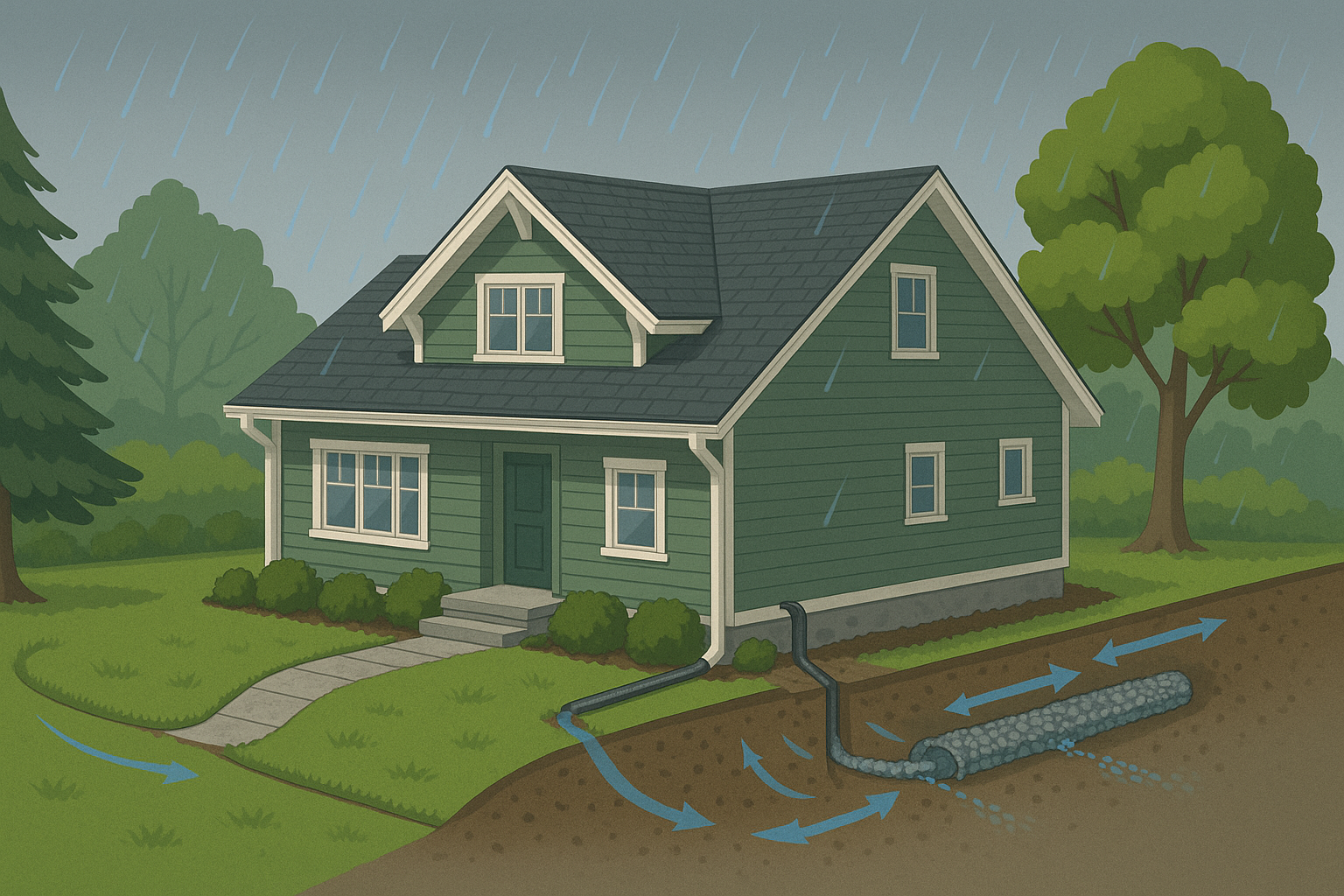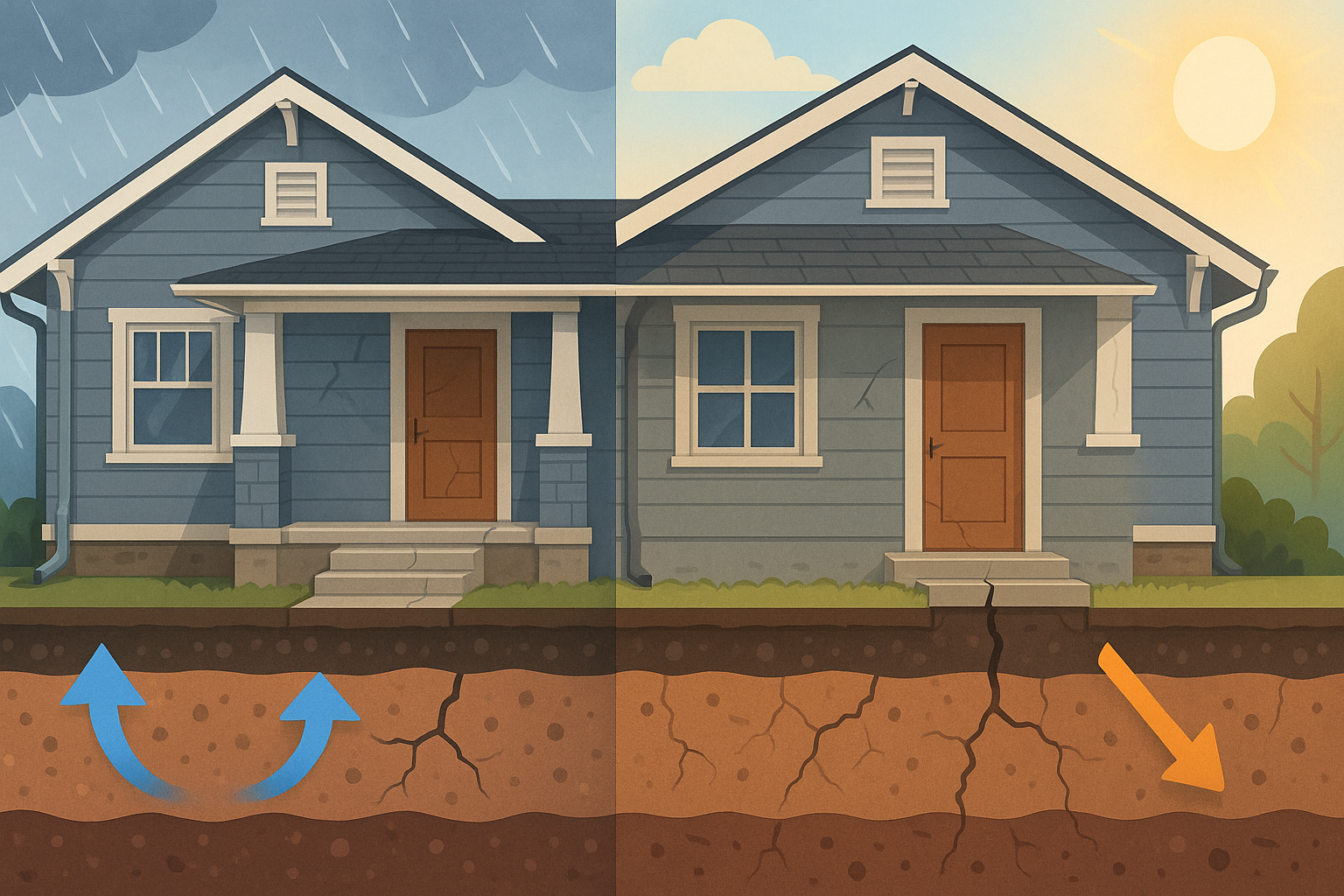Medford Drainage Basics: Keep Water Off Your Foundation

As the rainy season descends upon the Rogue Valley, homeowners know that water is an ever-present force. While essential for our lush landscapes, this same water can be a relentless enemy to your home’s foundation. In a region with heavy winter rains and expansive clay soil, managing water isn't just a good idea—it's the absolute first step in preventing costly foundation damage. Protecting your home starts from the outside in, by controlling and redirecting rainwater before it has a chance to wreak havoc on your foundation.
How Water Damages Foundations
When water is not properly channeled away from your home, it can lead to a host of problems, particularly in Southern Oregon's unique soil conditions.
- Hydrostatic Pressure: During heavy rains, soil around your foundation can become saturated. This creates immense lateral (sideways) pressure, known as hydrostatic pressure, that can push against basement and crawlspace walls, causing them to bow, crack, or leak.
- Soil Softening & Settlement: Excess water can soften and erode the soils that support your foundation. This loss of support can cause sections of your home to settle or sink, leading to uneven floors, sticking doors, and cracks in your drywall.
- Expansive Clay Cycles: The clay soil common in the Medford area swells dramatically when wet and shrinks as it dries. This constant cycle of expansion and contraction can lift and drop your foundation, causing significant structural stress and cracking over time.
- Crawlspace Humidity & Wood Rot: Water intrusion into a crawlspace creates a damp, humid environment perfect for mold, mildew, and wood-destroying fungi. This can compromise the structural integrity of your floor joists and beams, leading to sagging floors and poor indoor air quality.
Quick Wins Most Homes Need
Effective water management doesn't always require a massive overhaul. These simple, high-impact tasks are the first line of defense and can prevent many common drainage issues.
- Clean Gutters: Gutters should be cleaned at least twice a year, typically in the spring and fall. Clogged gutters will overflow, dumping water directly against your foundation. While you're up there, check for any sagging sections that could cause water to pool.
- Downspout Extensions: This is one of the most effective and affordable fixes. Your downspouts should discharge water at least 6 to 10 feet away from your foundation to prevent saturation of the soil next to your home.
- Splash Blocks and Diverters: Place splash blocks under each downspout to prevent erosion and help guide water away from the foundation.
- Slope Landscape Beds: Ensure that any mulch or soil in planting beds next to your home slopes away at a rate of 2-5%. This prevents them from acting like a sponge and holding water against the foundation.
Grading & Hardscape Fixes
Sometimes, the contours of your yard are the problem. Correcting the slope of the land and managing hardscaped areas is a critical next step.
- Regrade Low Spots: The ground around your foundation should slope away from the house, dropping at least six inches over the first 10 feet. Fill in any low spots near the foundation where water tends to pool.
- Swales: For properties on a slope, a swale—a shallow, wide ditch—can be an effective way to intercept and redirect surface water around your house instead of towards it.
- Permeable Pavers: If you're planning a new patio or walkway next to your home, consider using permeable pavers instead of solid concrete. These allow water to soak into the ground in a controlled way rather than running off toward your foundation.
- Driveway Trench Drains: If your driveway slopes toward your garage or home, a trench drain can be installed to capture water and pipe it away to a safe location.
French Drains & Sump Pumps — When to Install
When surface-level fixes aren't enough, a more robust system may be needed to manage subsurface water.
A French drain is essentially a gravel-filled trench containing a perforated pipe that collects groundwater and channels it away from your foundation. They are highly effective in areas with heavy clay soil, on sloped properties, or on the "wet side" of a house that gets persistent water. A quality installation involves geotextile fabric to prevent the pipe from clogging with silt, a properly sloped trench, and a suitable discharge point away from the home.
In some cases, especially for basements or deep crawlspaces, gravity isn't enough to get the water out. This is where a
sump pump comes in. An interior drainage system channels water to a basin (the sump), and when the water reaches a certain level, the pump automatically kicks on and ejects the water to a location far from the house.
Basement & Crawlspace Considerations
The area below your home requires special attention to stay dry and healthy.
Wall Waterproofing: Applying a waterproof sealant or membrane to the exterior of basement walls during construction or excavation can be a powerful barrier against moisture.
Crawlspace Vapor Barriers: A thick plastic vapor barrier covering the entire dirt floor of your crawlspace is essential. It prevents ground moisture from evaporating into the crawlspace, reducing humidity and protecting the wood structure above.
Dehumidification: In crawlspaces or basements with persistent humidity issues, a professional-grade dehumidifier can be installed to keep the air dry and prevent mold growth.
Signs You Need a Pro
While some drainage tasks are DIY-friendly, certain signs indicate it's time to call for a professional assessment.
- Persistent pooling water around your foundation that doesn't drain.
- Musty odors in your basement or crawlspace, which suggest ongoing moisture issues.
- Water actively entering your basement or crawlspace during storms.
- Conflicts with your yard's grade and neighboring properties or city drainage systems.
Costs & Timeline
The cost and timeline for drainage solutions can vary widely.
- Simple Fixes: Gutter cleaning and downspout extensions are inexpensive DIY projects.
- Grading: Professional grading may cost several hundred to a few thousand dollars, depending on the scale.
- French Drains & Sump Pumps: A professionally installed French drain can range from $25 to $39 per linear foot in the Medford area. A full system with a sump pump can range from a few thousand dollars to over ten thousand, depending on the length, depth, access, and complexity of the system.
At Elite Foundation Repair, we believe in starting with the least invasive, most cost-effective steps first. A thorough assessment helps us pinpoint the true source of the problem so we can design a solution that works for your home and budget.
Ready to take control of your home's drainage? Schedule a drainage assessment with our team before the next big storm. We serve homeowners throughout Medford, Central Point, Talent, and Phoenix.
Frequently Asked Questions (FAQ)
Are French drains always the answer?
No, not always. About one in three homeowners who think they need a French drain may actually benefit more from simpler, less expensive solutions like correcting the grade or improving gutter systems. A professional assessment is key to identifying the right solution.
How far should downspouts extend?
Downspouts should extend a minimum of 6 to 10 feet away from the foundation to effectively move water away from the critical zone around your home.
Can landscaping cause drainage problems?
Absolutely. Landscape beds built up against the house can trap water. Large tree roots can also disrupt drainage patterns and even damage foundation walls over time. It's best to avoid heavy landscaping or irrigation right next to the foundation.
Do I need permits for drainage work?
It depends on the scope of the project. While simple fixes do not require a permit, significant excavation or systems that connect to city storm drains often do. In Oregon, installing storm water drainage may require a registered plumbing business. It's always best to check with your local jurisdiction.
Will this stop my foundation from sinking?
Proper drainage is a critical component of foundation stability. By preventing soil saturation and the dramatic shrink-swell cycles of clay soil, effective drainage systems remove a primary cause of foundation settlement and heave. For homes that have already experienced settlement, drainage improvements are often combined with foundation lifting solutions for complete stability.




